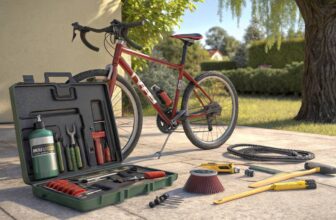Factors Influencing Bike Costs
Thinking about buying a hybrid bike? Well, there’s a bunch of stuff that’ll affect how much you’re gonna shell out. Whether it’s fresh off the assembly line or someone else’s castoff, that little detail matters a lot. And then there’s the whole materials thing – what the bike’s made of can change everything.
New vs. Used Bikes
When you’re trying to decide between a shiny new ride or a well-loved two-wheeler, it’s a classic debate among city slickers and weekend warriors. Both choices can be a bit of a mixed bag.
New bikes? They’re like a TikTok dance – trendy, untouched, and covered by warranties. But man, they can be pricey and lose value faster than a meme becomes outdated. You drop some big bucks on them, and next thing you know, they’re worth practically peanuts if you try to sell them.
Now, if you’re eyeing a pre-loved bike, your wallet might be happier. People on Bicycles Stack Exchange talk about how top-notch bike parts can last over 1500 km, so a used bike with top-tier gear might be a win. One rider snagged a Specialized SJ Evo for $2200 instead of $5000 new. That’s a good chunk of change saved, especially since the bike came spruced up with new brakes and gears.
Still, you gotta be Sherlock-level thorough checking out those used rides. Things like chains and gears might need swapping, meaning more money spent later. Here’s a little chart to break it all down:
| Type | Initial Cost | Possible Tune-Ups | Total Cost |
|---|---|---|---|
| New Bike | $500 – $3000 | Tiny Fixes | $500 – $3000 |
| Used Bike | $200 – $1500 | $100 – $500 | $300 – $2000 |
Thinking about sticking with your bike for a while? Better to think about hybrid bike maintenance and if you can easily get new parts down the line.
Material Impact on Price
What your hybrid bike’s made from can really jack up that price tag. You got your steel, aluminum, carbon fiber, and titanium. Each one’s got its perks and quirks.
Steel: Like your grandma’s cast-iron skillet, it’s tough and oh-so-nice for comfy rides. Sure, it ain’t light, but it might outlast you and any aluminum rival.
Aluminum: The featherweight champ, aluminum bikes won’t crush your muscles or your savings. Perfect if you’re zipping around the city. But they might not win any durability contests, especially on bumpy paths.
Carbon Fiber: Light as a feather but strong like a superhero. Just be careful with used ones; you don’t want to be surprised by cracks.
Titanium: The Ferrari of bike materials – ultra-strong, resistant to rust, and light. Needless to say, get ready to part with some serious dough. This one’s mostly for those high-end aficionados.
Here’s how the costs play out based on your material of choice:
| Material | Average New Cost | Pros | Cons |
|---|---|---|---|
| Steel | $300 – $2000 | Tough, Cushioned Rides | Heavy Baggage |
| Aluminum | $400 – $2500 | Light on the Load, Easy on the Wallet | Frail Build |
| Carbon Fiber | $1000 – $5000 | Feather-Light, Sturdy | Pricey |
| Titanium | $3000+ | Light as a Whisper, Rust-Proof | Breaks the Bank |
Figuring out the right material for your hybrid bike is like picking toppings for your pizza – it’s all about finding the right mix of cost, performance, and lasting power. Different stuff suits different journeys, whether you’re cruising the city streets or doing a long-haul tour. For the deep dive on materials, pop over to our hybrid bike frames guide.
By soaking up all these cost factors, future bike owners can snag a ride that fits their budget and biking style.
Affordable Hybrid Bike Options
Looking to snag a great hybrid bike without wiping out your wallet? Let’s check out some of the cool options available: the Boardman URB 8.9, Merida Speeder 200, Trek FX 2 Disc Equipped, and Cannondale Quick 3. These babies give you both quality and a decent price tag, so let’s break them down because choosing a bike shouldn’t feel like rocket science!
Boardman URB 8.9
Meet the Boardman URB 8.9: your new best friend on two wheels if you’re hunting for value with a splash of cool. It’s got a fancy Gates Carbon Belt Drive and an eight-speed Shimano Nexus internal gear hub – think almost zero fuss when it comes to keeping things rolling smoothly (Cyclingnews). At 10.7kg, it packs a quieter ride than your regular chain clunkers, making it spot-on for city trips or chill weekend rides.
| Spec | Deets |
|---|---|
| Drive | Gates Carbon Belt Drive |
| Gears | Shimano Nexus, 8-speed |
| Weight | 10.7kg |
To keep your ride in tip-top shape, check out our tips on hybrid bike care.
Merida Speeder 200
Next in line, the Merida Speeder 200. It’s got style and substance with a 6066 aluminum frame and carbon fork, weighing in at just about 10.46kg (Cyclingnews). This baby’s got internal cable routing, hydraulic disc brakes, and an FSA Tempo chain set to keep you purring along with ease and looking good while doing it.
| Spec | Deets |
|---|---|
| Frame | 6066 Aluminum |
| Fork | Carbon |
| Weight | 10.46kg |
Wanna know how these parts amp up your riding? Dive into the details of hybrid bike components.
Trek FX 2 Disc Equipped
The Trek FX 2 Disc Equipped is like the Swiss army knife of bikes. It’s packed with extras like lights, fenders, a hefty pannier rack, and a kickstand right off the bat (Cyclingnews). The frame responds like a dream, comfy enough for long treks or rugged trails. Plus, it can haul up to 136kg, so go ahead and bring those groceries.
| Spec | Deets |
|---|---|
| Gadgets | Lights, Fenders, Pannier Rack, Kickstand |
| Max Load | 136kg |
For more on gear and gadgets, see our write-up on hybrid bike racks.
Cannondale Quick 3
Got fitness on your mind? Enter the Cannondale Quick 3. It’ll keep you and your data on track with a built-in wheel sensor plus an Intellimount stem for mounting stuff (Cyclingnews). A slick carbon fork and aluminum frame paired with Shimano Acera and Altus parts in a 2×9 set-up assure a responsive and fun ride.
| Spec | Deets |
|---|---|
| Sensor? | You betcha |
| Stem | Intellimount |
| Gears | Shimano Acera and Altus, 2×9 |
Want to boost your ride? Find out more about hybrid bike fitness.
Picking from these budget-friendly hybrid bikes lets you strike the right balance between price and quality. You don’t have to go broke for good rides! For more on picking out the perfect hybrid and keeping it running right, dive into our articles on cheap hybrid bikes, hybrid bike maintenance, and the best commuter hybrid bikes.
Electric Bike Cost Factors
You know, figuring out what makes those electric bikes so pricey can be a real game-changer for city folks and Sunday riders looking to spring for one. A bunch of things influence the price tag, like the motor type and oomph, battery juice, build quality, and even fancy add-ons and the brand’s street cred.
Motor Type and Power
The heart and soul of an electric bike? The motor. It’s kinda like the life of the party, deciding just how much you’ll shell out. There are two big players here: mid-drive and hub motors. Mid-drive models are the fancy ones, nailing those uphill battles and tricky paths, which is why they cost more. They’re made for those who aren’t afraid to get their tires dirty. Meanwhile, hub motors are your budget-friendly besties, perfect for zipping around the city’s flat roads.
| Motor Type | Average Cost | Key Features |
|---|---|---|
| Hub Motor | $500 – $1,500 | Budget-friendly, great for city streets |
| Mid-Drive Motor | $1,000 – $3,500 | Powerful, aces varied terrains |
Battery Capacity
Now, let’s talk juice, as in battery. This is where the magic happens—or not—depending on how deep your pockets go. Bigger batteries mean you can ride forever (well, almost), but they definitely come with a heftier price tag. Most e-bikes today sport those shiny lithium-ion batteries because they last longer and kick lead-acid counterparts to the curb.
| Battery Type | Average Cost | Key Features |
|---|---|---|
| Lead-Acid Battery | $300 – $700 | Cheap but not exactly a long-term friend |
| Lithium-Ion Battery | $500 – $1,200 | Long-lasting champs |
Build Quality and Materials
Here’s the deal: the stuff your bike is made of matters—a lot. Super-light aluminum or snazzy carbon fiber frames mean you’re looking at a higher price, but they’re tough as nails and give you a smooth ride. Take the Honbike Uni4, for instance. Is it an aluminum frame? Top-notch for its strength and slick look.
| Frame Material | Average Cost | Key Features |
|---|---|---|
| Steel | $500 – $900 | Tough, but a bit on the heavy side |
| Aluminum | $900 – $2,000 | Light yet strong |
| Carbon Fiber | $2,000 – $5,000+ | Ultra-light and nimble |
Accessories and Brand Reputation
Wanna jazz up your ride? Accessories like fenders, lights, or racks can bump up that price. Bikes decked out with all the extras are pricier, but think about it: aren’t convenience and style worth it?
| Accessories Included | Cost Increase | Key Features |
|---|---|---|
| None | – | Riding barebones, buddy |
| Basic Set (Lights, Fenders) | $100 – $300 | The full month for serious commuting |
| Full Set (Racks, Bags, Locks) | $300 – $500+ | The full monty for serious commuting |
And of course, there’s the brand. Well-known names sometimes ask for more moolah ’cause they’re trusted for delivering the goods.
So, when you’re in the market for an electric bike, keep these bits in mind to snag a deal that works for you. Curious about keeping your hybrid whip in tip-top shape? Or maybe figuring out the right size? We’ve got a bunch of other reads for you to nosedive into.
Why High-End Bikes Cost More
Shelling out the big bucks for a top-tier hybrid bike might leave you wondering what makes them so pricey. Well, these bikes aren’t just slapped together; there’s some real thought and resources behind their sticker price. We’re talking about stuff like snazzy components, fancy materials, and a heap of work in labs to get everything just right.
Specialized Components
Peek under the hood of a high-end bike and you’ll see parts that are cut from a different cloth. These components are fine-tuned like a well-oiled machine, pushing performance and toughness to their limits. The folks over at Really Good Ebikes note that these custom parts can cost up to 30% more than your run-of-the-mill bike bits. Here’s some of the kit you might find:
- Super-lightweight carbon fiber frames
- Precise, slick-shifting gears and responsive brakes
- Sophisticated suspension systems for those bumpy trails
- Featherweight alloy rims
These bells and whistles can make your ride a dream whether you’re commuting to work or tackling varied terrains.
Construction Materials
What makes these bikes so fancy? It’s in the stuff they’re made of! Bikes that don materials like carbon fiber, titanium, and sleek alloys tend to rack up the costs. These aren’t just your average metal and plastic; they’re premium, offering strength minus extra pounds. The investment in these materials adds to the price, but it’s all about achieving a performance edge and lasting durability (Really Good Ebikes).
| Material | Perks | Cost Upshot |
|---|---|---|
| Carbon Fiber | Lightweight, mighty | Pricey, top-notch speed |
| Titanium | Tough, rust-proof | Costly, boosts life span |
| Aluminum | Light, budget-friendly | Easy on the wallet, standard choice |
Such materials make each bike ride-ready for uses like fitness rides or city cruising.
Research & Development Costs
Getting a high-end bike isn’t about slapping on some paint and stickers—it means R&D work rooted in innovation. Makers of these marvels pump tons of cash into dreaming up features that make the bikes go faster, last longer, and keep riders safe (Really Good Ebikes).
| R&D Focus | Payoff |
|---|---|
| Performance Boosts | Elevates the ride game |
| Toughness Tests | Makes parts outlive the user |
| Safety Basics | Shields the rider |
These investments are factored into what you fork out, pledging a bike that zooms and protects like no other.
To dive deeper into the nuts and bolts driving the price, head over to our components guide. Or, if you’re frame-geek, explore how different bike frames tweak the total cost, giving you the key to a sound bike-buying decision.




